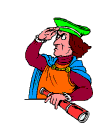
"Occupations at Sea"

GOALS:
1. Compile research on a specific occupation at sea.
2. Write a journal entry story about a researched occupation.
3. Work cooperatively and effectively with a partner.
RESOURCES:
1. "Occupations at Sea" worksheet
2. Sakamoto Steidl, Kim. Environmental Portraits; People Making a Difference for the Environment. Carthage: Good Apple, 1993.
3. Various resource books/access to the school library
4. Internet
LESSON ADAPTED FROM:
Fuller, Mel. (1994). Whole Language Theme Unit: The Seas. Grand Rapids: Instructional Fair, Inc.
TIME:
This lesson will require 2 hours, 20 minutes to 3 hours, 5 minutes. (Part 1 [15 minutes]; Part 2 [1 hour 30 minutes to 2 hours 5 minutes]; Part 3 [35 minutes])
PROCEDURE:
Introduction:
This lesson will create an awareness of the different occupations at sea.
Part 1:
Step 1- Ask the class to name an occupation at sea. Have discussion
Examples of occupations at sea:
Marine Biologist
Scuba Diver
Oceanographer
Navy
Coast Guard
Captain of a ship
Sea Animal Trainer from a Theme Park or Aquarium
Off-shore oil worker
Fisherman
Marine Photographer
Step 2 - From answers accumulated from Step 1, each student will conduct an "Occupation at Sea" interview. (See attached worksheet.) Each student must research the occupation assigned on the worksheet. Research can be obtained from the internet, newspapers, library, magazines. Compile information on the "Occupations at Sea" worksheet.
Step 3 - With compiled information from the "Occupation at Sea" worksheet, each student will journal write a story of a day in this occupation.
Examples:
What time does your day start/end?
What equipment is needed?
Would this be an occupation of your choice?
What does your day consist of?
Part 3:
Step 4 - Each student will then pair up with another student and share their "Occupations at Sea" worksheet and journal writing.
Step 5 - Turn worksheet and journal in to the teacher.
ASSESSMENT:
1. Teacher will make assessment on the "Occupations at Sea" worksheet. (Criteria for success = X number of questions answered correctly on worksheet and X number of supplement questions. Reasonable criteria %= 80% of questions answered correctly.)
2. Each student must turn in his/her journal. (Criteria for success= One detailed entry on the student's researched occupation at sea. See Journal Rubric.)
3. Teacher and students will make assessment of partner work. (Criteria for success = See Teacher and Student Rubrics for Partner Work.)
CURRICULAR STRANDS AND MAJOR CONCEPTS:
1. Language Arts - Communicating with partners and the class; journal writings; using library resources.
2. Science - Researching occupations of the sea.
3. Social Studies - Researching occupations of the sea.
POSSIBLE EXTENSIONS:
1. Explore educational backgrounds
Example: Could any of the occupations researched be obtained without a high school diploma or college degree?
2. Invite a community member to class that is involved in an "Occupation at Sea"
Lesson Plans List